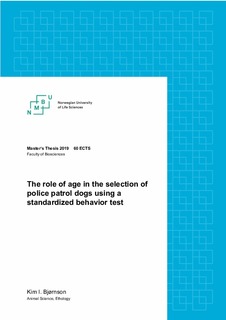| dc.description.abstract | Police patrol dogs face many challenging situations, and only a proportion of dogs are suitable for this work. It is desirable to identify suitable dogs as early as possible, allowing unsuited dogs to be released for other purposes and reducing the emotional cost of separating the dog and handler at a later age. However, the selection process may be less reliable when dogs are young and their personality is less established. I investigated the stability of dog behavior in the different successive subtests of a standardized behavior test conducted at two different ages, and test outcome of each test (pass or fail, based on expert evaluation by testers). I also examined the extent to which behavior in the first test predicted the outcome of the second test. A standardized test was administered twice to 62 male German shepherds by Norwegian and Swedish police dog testers (N = 31 dogs per country) approximately 6 and 12 months of age (mean ± SD: 6.14 ± 0.50 vs 12.31 ± 0.64 months). Tests comprised 63 behavioral variables assessed across 14 subtests designed to measure behavioral responses in different situations. Each variable was scored from 1 to 5, with higher scores representing more desirable responses, and the mean score for each subtest was calculated. A positive association was found between test outcomes at 6 and 12 months (χ2 = 14.78, p <0.001), with 74.2% of dogs having the same outcome at both ages. Bland-Altman plots identified 7 subtests with mean scores that showed consistency in the interval 6-12 months. Binary logistic regression models identified that the mean scores from 3 subtests at 6 months, and 4 at 12 months, were significant predictors of test outcomes at the age tested. Furthermore, 3 subtests at 6 months were significant predictors of test outcomes at 12 months. I compared the mean score from the 3 subtests between dogs that A) passed at both ages (n = 21), B) failed at 6, but passed at 12 months (n = 13) or C) failed at both ages (n = 25). Back-transformed least squares mean scores (± SD) adjusted for multiple comparisons were higher for dogs in category A (4.23 ± 0.36) than B (3.90 ± 0.37, z = 2.62, p = 0.024) or C (3.41 ± 0.35, z = 7.74, p <0.001), and category B scores also exceeded category C scores (z = 4.00,
p <0.001). These results suggest that some subtests are more predictive of test outcomes than others. They also suggest that testing can be implemented at the earlier age to exclude low scoring dogs and accept high scoring dogs while leaving open the possibility of a second test when older for a relatively small subset of young dogs with ambiguous (intermediate) test results. | nb_NO |

